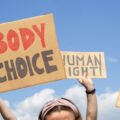Insights from the dashboard: Ethics and abortion in 2022
Insights from the dashboard: Ethics and abortion in 2022
In the first half of 2022, the debate on abortion was alive and heated.
Abortion on the EARS dashboard
The EARS dashboard offers different perspectives on various topics surrounding the relationship between religion and society in Europe. Over the past 12 months, our international team of analysts has added over 3,500 summaries of articles published by the European media. The dashboard offers various insights on themes that are discussed in these articles. It allows users to explore the interrelations between different topics, the prevalence of particular themes, and connections to global developments.
An important recurring theme in the European media and on the EARS dashboard is abortion. Abortion has been a controversial topic for decades. But since the US Supreme Court announced that it plans to abolish the federal right to abortion, it has become a highly prevalent point of discussion in the media. In May 2022, the US Supreme Court drafted a decision to overturn the ruling on the right to abortion that has existed since 1973.[1] If this decision is adopted, abortion will be banned or restricted in more than half of US states.[2]
The EARS dashboard shows how the timing of this decision coincides with a significant rise in summaries published on the theme of abortion:

The Venn diagram below shows the various interrelated topics that fall within the theme of abortion:

Protest and abortion
An important topic that coincides with the theme of abortion is protest. The decision of the US Supreme Court to abolish the right to abortion was met with protest. In May 2022, people gathered in Amsterdam to defend and advocate the right to abortion. This demonstration represents a counterreaction to the recent developments taking place in the United States. The right to abortion in the Netherlands is fairly secure at the moment. In February 2022, the Dutch House of Representatives decided to abolish the mandatory five-day reflection period in cases of abortion. Nevertheless, Dutch pro-life organisations are putting pressure on the issue. These organisations also represent the theme of protest. Christian foundation ‘Schreeuw om Leven’ (Scream for Life) and political party ‘Jezus Leeft’ (Jesus Lives), for example, both regularly protest against abortion.[3] In the Netherlands, religious pro-life protesters have been active for years. Protesters bang on car windows, block the entrance to abortion clinics, and hand out leaflets with shocking images. Protests like these occur weekly.[4] Hence, abortion-related protests can come from two sides: from those in favour of abortion and from those who are against it.
Ethics and abortion
The sense of protest involved in the debate on abortion is rooted in a dominant theme found in the Venn diagram: ethics. Abortion-related protests are rooted in moral disagreement. This means that there is a tension between different ethical values: the right to life and the right to self-determination. This represents another important theme shown in the Venn diagram above: tension.
Hence, the issue of abortion provokes a tension in the field of ethics. On one side of the debate, there are people who give priority to the value of life. They oppose the right to abortion because they believe that unborn life should be protected. On the other side, there are people who give priority to the value of self-determination. They support the right to abortion because they believe that women should have the right to make decisions about their own bodies. This signifies the tension between a pro-life ethics and a pro-choice ethics.[5]
Religious institutions tend to be strongly pro-life. In Spain, new laws that facilitate abortion have been met with criticism from Catholic institutions. These criticisms assume a fundamentally moral language and a moral perspective that is rooted in the value of life. The new laws ensure that 16- and 17-year-olds no longer have to get permission from their parents to get an abortion. The cardinal of Madrid, Carlos Osoro, spoke out against these laws by emphasising the significance of life. He claimed that human beings have a duty to protect life and should not legislate to end it.[6]The bishop of Málaga, Jesús Catalá, also expressed criticism of the new legislation. He stated that the Church defends human life, from conception to natural death. According to the bishop, the elimination of life at any stage is murder.[7] Antonio Cañizares, the cardinal of Valencia, likewise used strong moral language to criticise the new laws. He called the laws “wicked” and declared that they were “against life.”
Interrelations
The EARS dashboard shows how in the first five months of 2022, the moral debate on abortion was alive and heated. It shows how the topics of ethics, tension, and protest overlap within the overarching theme of abortion. The interrelation between ethics and abortion is shown to be most central to this debate. The themes of tension and protest directly relate to the ethical character of the debate on abortion: both stem from moral disagreement.
Learn more on the EARS dashboard
The EARS dashboard allows you to gain insight into a large number of topics, including abortion and ethics. It is a free tool that allows you to make connections like those described above, and to find out about relationships between interesting subjects across Europe. Please visit the dashboard to learn more.
Want to learn more about similar topics? Go to the EARS Dashboard.
Sources
[1] Recht auf Abtreibung in USA vor dem Aus?
[2] Op de dam klinkt opnieuw de roep om het recht op abortus
[3] Op de dam klinkt opnieuw de roep om het recht op abortus
[4] Deel Tweede Kamer wil landelijk verbod op demonstraties bij abortusklinieken: ‘Kan echt traumatisch zijn’
[5] Op de dam klinkt opnieuw de roep om het recht op abortus
[6] Carlos Osoro: “El aborto es un fracaso”
[7] Jesús Catalá: “Nadie tiene derecho a eliminar una vida humana, eso se llama asesinato”






